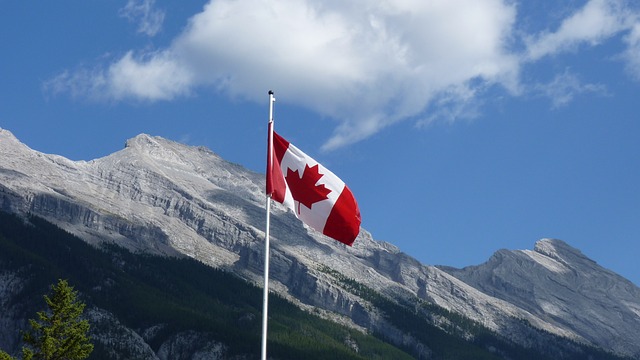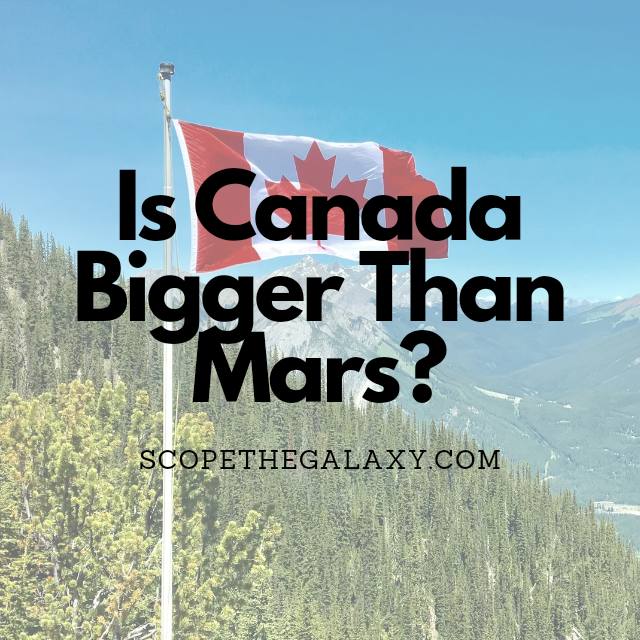*This post may contain affiliate links. This means we may make a commission if you purchase an item using one of our links*
Canada is the second largest country on Earth, while Mars is the second smallest planet in our solar system. As a result it only makes sense that it’d be bigger with a surface area of 144.8 million sq. km compared to Canada’s 9.98 million sq. km whereas Canada’s volume is far smaller at 349.4 million cubic km compared to Mars’ astronomically larger 163 billion cubic km.
For a more thorough breakdown of what makes both Canada and Mars as big as they are continue reading as it will be covered in more detail below.
How Big Is Canada?

Canada is one of the world’s largest countries, second only to the vast expanse of Russia. Still, with a population of just over 38 million, it remains one of the least densely populated countries, with more than 10 million people.
Canada has a total area of 9,984,670 sq. km, which encompasses its land mass and vast stretches of water. This country possesses an estimated 31,752 lakes, giving it the greatest number of lakes of any country in the world – they account for 9% of the country’s total surface area.
Without these, Canada would be smaller than both China and the US, possessing a land area of “just” 9,093,510 sq. km.
Canada has a width of 5,514km between its most extreme easterly point of Cape Spear across to the Yukon and Alaska boundaries. Its height – from Cape Columbia to Ontario – is 4,634km at its peak. And it has the longest coastline in the world, stretching over 240,000km. Canada is so big that the UK could fit inside it over 40 times.
Canada’s border with the USA is the longest in the world, with a length of 8,891km; this also holds the title for the longest undefended boundary in the world. In addition, the sheer size of Canada means that it borders three oceans: the Atlantic, the Pacific, and the Arctic. And from east to west, the country covers six time zones.
Roughly 24% of Canada’s total land area comprises mountains, with the tallest peak being Mount Logan which reaches a height of 5,959 meters. Still, the vast number of lakes reduces the average thickness of Earth’s crust. Scientists estimate that the thinnest strips of crust are around 29 km thick. But the average thickness is between 30 and 40 km.
If we take the average thickness to be 35 km and multiply it by the total surface area, we can calculate the estimated volume of Canada to be around 349,463,450 cubic km.
Canada’s diverse physical geography encompasses towering mountains, rolling plains, and expansive lakes. The Canadian Shield is a northern hilly region of swamps and lakes that contains some of the oldest rocks in the world. Further north, ice and snow dominate the landscape in the glacial Arctic regions.
How Big Is Mars?

Mars is the fourth planet in line from the Sun and the second smallest planet in our solar system. It has a diameter of 6,779 km, which is only just over half as large as Earth’s (around 53%)
The physical geography of Mars is very different from that of Earth. The atmosphere on Mars is much thinner than ours, and it consists mainly of carbon dioxide (CO2) with small amounts of nitrogen (N2). The surface gravity on Mars is much lower than that on Earth, so an object that weighs 100 pounds on Earth, would weigh just 38 pounds on the red planet.
The surface of Mars is mainly composed of various minerals like iron oxide and silicon dioxide. It also has polar ice caps, but it doesn’t have any oceans or seas.
Olympus Mons is the largest volcano on Mars, with a diameter of 600km. And it is the largest mountain in our solar system, standing at roughly 27km high (almost three times the height of Mount Everest)
The Valles Marineris system of valleys is a vast network of canyons on Mars; the largest canyon in the solar system. It is located in the planet’s southern hemisphere and extends for around 4000 kilometers from east to west; the deepest points can extend up to 10km.
The basic makeup of Earth and Mars is similar as they are both terrestrial planets with a dense metallic core and overlying crust and mantle. However, Earth’s density (5.514g per cubic cm) is higher than Mars’ density (3.93g per cubic cm), suggesting that the red planet’s core contains lighter elements than Earth’s.
The surface area of Mars is around 144.8 million sq. km, about 14.5 times the surface area of the Canada. Meanwhile, the volume of Mars is approximately 163 billion cubic kilometers, roughly 466 times that of Canada.
Summary
Mars is far bigger than Canada as its a spherical object while Canada is a flat land mass that is 15 times smaller.
Furthermore, in terms of volume Mars is 460 times that of Canada which makes absolute sense when you take into account it is a planet while Canada is simply 1 small sector of a planet

